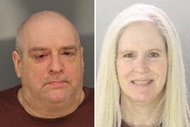What Is 'The Matrix' Defense — And Does Claiming Real Life Is A Simulation Actually Work?
Tonda Lynn Ansley and Vadim Mieseges, who both murdered their landlords, avoided prison by claiming they were living in a non-reality.

While "The Matrix” movie franchise is decidedly fiction, some criminal suspects have used the metaphysical concepts put forth in the films to try to justify their crimes, and in doing so, have turned courtrooms into a cinematic arena of their own.
The main premise of “The Matrix,” the 1999 blockbuster which kicked off the science-fiction series, is that the world is actually a computer-generated simulation. This simulation theory — that the world we see before us is not, in fact, real — was nothing new 22 years ago. In fact, philosophers have proposed that our reality could be an illusion for centuries.
With the advent of the computer, this morphed into the notion that the world is in fact a computer-based illusion. Since the 1960s, science-fiction authors have written stories about humans being trapped in such simulations. Philip K. Dick wrote a short story title "We Can Remember It for You Wholesale," in 1966, which focused on this premise; it was later adapted into the 1990 film, "Total Recall," with Arnold Schwarzenegger. Dick then gave a 1977 speech detailing the theory. The 1983 television movie, “Overdrawn at the Memory Bank,” focused on a man who has his mind connected to a simulation. And a 1993 “Star Trek: The Next Generation” episode also featured people trapped inside a simulation.
However, the widely seen “Matrix” movies, which present a world in which humans live in pods and experience life through a simulation tube hooked to their skull, popularized the theory globally.
"When it was released, 'The Matrix' may have been the most compelling and popular illustration of the idea because it capitalized on new CGI technology and special effects that were not available to filmmakers in the past," Adam Lankford, a criminal justice professor at the University of Alabama, told Oxygen.com.
“Glitch in The Matrix,” which hits theaters and On Demand on Friday, reveals how the theory has been brought into the courtroom as a defense. It touches on the case of Joshua Cooke, a 19-year-old who murdered his adoptive parents with a shotgun in 2003 in Virginia.
A 2003 Boston Globe piece dramatically set the scene:
Josh Cooke doesn't remember what he was thinking at 7:30 p.m. on Monday, Feb. 17, when he went up to his room after eating dinner with his parents. He remembers what he was listening to on his headphones — "Bodies," by metal drones Drowning Pool — and what he did. "I just kinda looked over at my `Matrix' poster," he says, "and then I looked over at my gun."
The 19-year-old donned combat boots and a black jacket — like Neo, the hero of the 1999 movie and its sequels. He filled his pockets with shotgun shells. Then he picked up the 12-gauge he'd bought because it looked like the one in the poster of his favorite movie, and he marched downstairs. "I guess you know the rest," he says.
Before Cooke went to trial, a court-appointed psychologist stated he "harbored a bona fide belief that he was living in the virtual reality of 'The Matrix,’” the Washington Post reported in 2003. Mani Fierro, one of Cooke's defense attorneys stated on a 2003 episode of "The O'Reilly Factor" that his "client was obsessed with the movie 'The Matrix,'" Fox News reported. He confirmed that the defense team had filed a motion putting forth the claim that Cooke "did believe he was in a virtual reality world similar to 'The Matrix.'"
While blaming “The Matrix” for murder may seem strange, he wasn’t the first to pin a crime on the influential film. In fact, the Boston Globe noted he was the third killer to use it, or come close to using it in court, in a move that has become known as "The Matrix” defense. That same year, Lee Boyd Malvo, who along with John Allen Muhammad, killed 10 people in sniper attacks in the Washington, D.C. area over a three-week period, blamed the movie for his actions. Malvo, then just a teen, told FBI agents that “The Matrix” holds the key to understanding him, according to the Globe.
"Free yourself of the matrix," he wrote in his jail cell, the Washington Post reported in 2003. "You are a slave to the matrix 'control.'"
His attorneys, too, planned to include the movie's ideas in their insanity defense.
In the end, Cooke took legal responsibility for the murders, ditching the defense and pleading guilty to two counts of first-degree murder and two counts of using a gun in a felony. As for Malvo, his lawyers too eventually opted not to use the so-called “The Matrix” defense, either. While Malvo pleaded not guilty by reason of insanity, his attorneys seemed to focus more on how video games affected him. Eventually, he too was found guilty of murder.
Others around the time, however, succeeded in pleading insanity using “The Matrix” defense, landing them in mental health treatment facilities rather than prisons following murders. Ohio woman Tonda Lynn Ansley shot her landlord and employer, Sherry Lee Corbet, to death in 2002 and then began talking about “The Matrix,” alluding to the idea that she didn’t think she was actually committing murder in reality.
"They commit a lot of crimes in ‘The Matrix,’” she told police following her arrest, ABC News reported in 2003. “That's where you go to sleep at night and they drug you and take you somewhere else and then they bring you back and put you in bed and when you wake up, you think that it's a bad dream.”
She was found innocent by reason of insanity.
Swiss exchange student Vadim Mieseges also shot his landlord and then blamed "The Matrix." In May 2000, after gunning his landlord down, he skinned and dismembered her body before dumping her in San Francisco's Golden Gate Park, the Boston Globe reported. He blamed his use of meth as well as his fear of getting "sucked into the Matrix" for the killing. He was found innocent by reason of insanity.
Given the handful of these defenses that have emerged in murder cases, Warner Bros. Pictures issued a statement in 2003, saying that "any attempt to link these crimes with a motion picture [...] is disturbing and irresponsible," the Boston Globe reported.
These cases, which all happened within a short time following the 1999 release of the first "Matrix" movie, attracted media attention and stirred up questions — particularly, why was this film being blamed and why did there seem to be such a spurt of cases like this?
"The ‘Matrix’ films offer several themes that could be attractive to many viewers: that their dissatisfaction with their life is to blame on powerful and manipulative forces, that escape is possible, and that fighting back will be empowering and heroic," Lankford told Oxygen.com. "Along with influencing countless fans who are psychologically healthy, it's not surprising that these movies might influence some severely mentally ill people as well."
Lankford added that the themes of this movie, in which morality is blurred, is appealing as a defense.
"For defense attorneys, part of the insanity defense is typically arguing that your client couldn't distinguish right from wrong," he explained. "So these lawyers might be prone to emphasize the influence of ‘The Matrix’ because it frames violence as morally justified. If their clients also believed they were being controlled by the U.S. government or the CIA, for example — as other mentally ill criminals have claimed in the past — that is harder to use because most people would be expected to know that violence against the government or its agencies is wrong, even if you disagree with them."
The defense mirrors the so-called "Taxi Driver" defense of John Hinckley, who tried to assassinate President Ronald Reagan in 1981 in order to impress Jodie Foster, who appeared in that 1976 Martin Scorsese film. Hinckley's lawyers blamed the influence of "Taxi Driver," which involves a man trying to assassinate a political candidate to impress a woman. Hinckley was found not guilty by insanity, spurring controversy and leading to the creation of the Insanity Defense Reform Act of 1984, which made it significantly more difficult to be found guilty by insanity.
"It's quite clear that some people are powerfully influenced by the role models they see in the news, on television, and in the movies," Lankford told Oxygen.com. "But that fact is not sufficient for proving legal insanity, inability to distinguish right from wrong, or inability to control one's behavior."
Furthermore, he said there is no clear evidence that suggests that movies of any kind influence violent behavior. While that particular era — the 1990s and early 2000s — was known for turning to movies and video games as causation for murder, "over recent decades the trends have been going in opposite directions, with violence increasing in entertainment content but decreasing in society — which suggests there is no simple cause and effect relationship overall."
Lankford specified that there are some high-profile crimes, like mass shootings, where media contagion is supported by evidence. But the inspiration in those cases is linked to real "idols," he says, like previous mass shooters rather than fictional characters.



























